Preparation and Performance of Ferric-Rich Bauxite-Tailing-Based Thermal Storage Ceramics
Abstract
:1. Introduction
2. Experimental Procedure
2.1. Raw Materials
2.2. Preparation
2.3. Characterization
3. Results and Discussion
3.1. Composition and Phase Analysis of Bauxite Tailings
3.2. Preparation and Performance Study on Ferric-Rich Bauxite-Tailings-Based Thermal Storage Ceramics
4. Conclusions
- (1)
- The phase transformation of bauxite tailings in the heating process is mainly from diaspore, kaolinite, and illite to mullite and corundum, and the products are finally mullite, corundum, quartz, and hematite. The high heat capacity properties of mullite and corundum and the high specific gravity of hematite can be used for the preparation of thermal storage ceramics
- (2)
- In the preparation of bauxite-tailing-based ceramics, appropriate Fe2O3 can promote the formation of liquid phase, thus promoting the ceramic compact and phase transition of mullite, and corundum. A too-high Fe2O3 concentration will lead to the reduction of liquid phase components, which is not conducive to the preparation of ceramics.
- (3)
- When the Fe2O3 content is 15 wt% and sintering temperature is 1000 °C, ferric-rich bauxite-tailing-based ceramic materials can be obtained with a bulk density of 2.53 g/cm3, apparent porosity of 9.64%, water absorption of 3.81%, linear shrinkage of 9.92%, compressive strength of 120.81 MPa and specific heat capacity of 1.06 J/(g·K), which meet the requirements of the industry and market. The preparation process plays an active role in the utilization of bauxite tailings and the reasonable development of inferior component Fe2O3.
Author Contributions
Funding
Data Availability Statement
Conflicts of Interest
References
- National Bureau of Statistics. China Statistical Yearbook on Environment; China Statistics Press: Beijing, China, 2022. [Google Scholar]
- Raghubanshi, A.S.; Mudgal, M.; Chouhan, R.K.; Kumar, A.; Srivastava, A.K. Recycling and potential utilization of red mud (Bauxite Residue) for construction industry applications. Indian J. Eng. Mater. Sci. 2022, 29, 401–410. [Google Scholar]
- Page, J.R.; Manfredi, Z.; Bliznakov, S.; Valla, J.A. Recent Progress in Electrochemical Upgrading of Bio-Oil Model Compounds and Bio-Oils to Renewable Fuels and Platform Chemicals. Materials 2023, 16, 394. [Google Scholar] [CrossRef] [PubMed]
- Lu, Q.; Hu, Y. Characteristics of Bauxite Flotation Tailings. Acta Mineral. Sin. 2012, 32, 537–542. [Google Scholar]
- Yu, T.; Liu, W.; Chen, X.; Li, W. Study on Preparation of New Geopolymeric Cement with Tailings from Bauxite Beneficiation. Conserv. Util. Miner. Resour. 2012, 6, 45–49. [Google Scholar]
- Meng, Y.; Gong, G.; Wu, Z.; Yin, Z.; Xie, Y.; Liu, S. Fabrication and microstructure investigation of ultra-high-strength porcelain insulator. J. Eur. Ceram. Soc. 2012, 32, 3043–3049. [Google Scholar] [CrossRef]
- Kong, X.; Tian, Y.; Chai, Y.; Zhao, P.; Wang, K.; Li, Z. Effects of pyrolusite additive on the microstructure and mechanical strength of corundum-mullite ceramics. Ceram. Int. 2015, 41, 4294–4300. [Google Scholar] [CrossRef]
- Lv, Q.; Dong, X.; Zhu, Z.; Dong, Y. Environment-oriented low-cost porous mullite ceramic membrane supports fabricated from coal gangue and bauxite. J. Hazard. Mater. 2014, 273, 136–145. [Google Scholar]
- Chen, X.; Li, T.; Ren, Q.; Wu, X.; Dang, A.; Li, H.; Zhao, T. Fabrication and morphology control of high strength lightweight mullite whisker network. J. Alloys Compd. 2017, 729, 285–292. [Google Scholar] [CrossRef]
- Ma, H.; Tian, Y.; Zhou, Y.; Li, G.; Wang, K.; Bai, P. Effective reduction of sintering temperature and breakage ratio for a low-cost ceramic proppant by feldspar addition. Int. J. Appl. Ceram. Technol. 2018, 15, 191–196. [Google Scholar] [CrossRef]
- Martucci, A.; Aversa, A.; Lombardi, M. Ongoing challenges of laser-based powder bed fusion processing of Al alloys and potential solutions from the literature—A review. Materials 2023, 16, 1084. [Google Scholar] [CrossRef]
- Badea, S.-L.; Niculescu, V.-C.; Iordache, A.-M. New Trends in Separation Techniques of Lithium Isotopes: A Review of Chemical Separation Methods. Materials 2023, 16, 3817. [Google Scholar] [CrossRef] [PubMed]
- Guo, B.; Ma, D.; Zuo, L.; Guo, M.; Zhang, M. Influence of Impurites in Bauxite Tailings on Performance of Mullite-based Multiphase Materials. Environ. Eng. 2021, 39, 150–156. [Google Scholar]
- Zhang, A.; Min, X.; Wang, Q.; Fang, M.; Chen, X. Study on the Direct Firing of Bauxite Tailings to Prepare Ceramic Materials and Their Mechanical Properties. Miner. Prot. Util. 2022, 42, 121–127. [Google Scholar]
- Li, Z.; Ma, X.; Niu, J.; Zhao, L.; Lu, Y.; Fei, Y.; Cao, J. Performances control of sintered permeable bricks prepared with bauxite tailings. J. Henan Univ. Urban Constr. 2021, 30, 60–65. [Google Scholar]
- Ma, X.; Dong, E.; Zhang, C.; Ji, J.; Yu, X.; Zhang, J.; Niu, J. Thermal Activation Effectiveness of Bauxite Tailings. J. Mater. Sci. Eng. 2021, 39, 420–425. [Google Scholar]
- Li, L.Y. Properties of Red Mud Tailings Produced under Varying Process Conditions. J. Environ. Eng. 1998, 124, 254–264. [Google Scholar] [CrossRef]
- Yang, F.; Wang, Q.; Min, X.; Fang, M.; Huang, Z.; Liu, Y.; Wu, X.; Mi, R.; Liu, C.; Liu, Y.; et al. Influence of Low Grade Spodumene on Preparation of Mulite-based Compound Ceramics with Bauxite Tailings. Met. Mine 2022, 9, 244–250. [Google Scholar]
- Zhang, Y.; Zhang, J.; Wu, L.; Tan, L.; Xie, F.; Cheng, J. Extraction of lithium and aluminium from bauxite mine tailings by mixed acid treatment without roasting. J. Hazard. Mater. 2021, 404, 124044. [Google Scholar] [CrossRef] [PubMed]
- Ou, X.; Huang, Z.; Luo, B.; Qin, J.; Jiang, J.; Lv, Z. Model test study on treatment of bauxite tailing slurry by adding sand step by step combined with quicklime drainage and solidification. J. Eng. Geol. 2023, 31, 318–326. [Google Scholar]
- Zhou, L.; Gou, M.; Zhang, H. Investigation on the applicability of bauxite tailings as fine aggregate to prepare 3D printing mortar. Constr. Build. Mater. 2023, 364, 129904. [Google Scholar] [CrossRef]
- Qiang, Z.; Shen, X.; Guo, M.; Cheng, F.; Zhang, M. A simple hydrothermal synthesis of zeolite X from bauxite tailings for highly efficient adsorbing CO2 at room temperature. Microporous Mesoporous Mater. 2019, 287, 77–84. [Google Scholar] [CrossRef]
- Mendes, B.C.; Pedroti, L.G.; Bonomo, B.R.; Lucas, A.C.L.; Silva, L.S.; Lopes Márcia, M.S.; Lima, G.E.S.D. Effect of the Incorporation of Bauxite and Iron Ore Tailings on the Properties of Clay Bricks. In Characterization of Minerals, Metals, and Materials; Springer: Berlin/Heidelberg, Germany, 2021; pp. 361–372. [Google Scholar]
- Knoll, M.; Schomaecker, R.; Bungert, B. Catalytic Activity of Ceramic Honeycombs in the Exhaust Gas Oxidation of a Waste Treatment Plant. Chem. Eng. Technol. 2019, 42, 422–431. [Google Scholar] [CrossRef]
- Wang, B.; Shang, Q.; Liu, M.; Sun, C.; Wang, Z.; Cai, X. Damage Mechanism and Improvement Measures of Honeycomb Ceramics in Regenerative Thermal Oxidizer. China Ceram. 2020, 56, 20–26. [Google Scholar]
- Du, W.; Chen, S.; Qiang, S. The Recent Progress of Pitch Nanoengineering to Obtain the Carbon Anode for High-Performance Sodium Ion Batteries. Materials 2023, 16, 4871. [Google Scholar] [CrossRef] [PubMed]
- Chang, Y.; Yao, X.; Chen, Y.; Huang, L.; Zou, D. Review on ceramic-based composite phase change materials: Preparation, characterization and application. Compos. Part B Eng. 2023, 254, 110584. [Google Scholar] [CrossRef]
- Wang, S.; Gainey, L.; Mackinnon, I.D.R.; Xi, Y. High- and low-defect kaolinite for brick making: Comparisons of technological properties, phase evolution and microstructure. Constr. Build. Mater. 2023, 366, 130250. [Google Scholar] [CrossRef]
- Wang, G.; Wang, H.; Zhang, N. In situ high temperature X-ray diffraction study of illite. Appl. Clay Sci. 2017, 146, 254–263. [Google Scholar] [CrossRef]
- Ren, Y.; Ren, Q.; Wu, X.; Zheng, J.; Hai, O. Mechanism of low temperature sintered high-strength ferric-rich ceramics using bauxite tailings. Mater. Chem. Phys. 2019, 238, 121929. [Google Scholar] [CrossRef]
- Wang, S.; Gainey, L.; Marinelli, J.; Deer, B.; Wang, X.; Mackinnon, I.D.R.; Xi, Y. Effects of vermiculite on in-situ thermal behaviour, microstructure, physical and mechanical properties of fired clay bricks. Constr. Build. Mater. 2022, 316, 125828. [Google Scholar] [CrossRef]
- JC-T 2135-2012; Honeycomb Ceramic Heat Accumulator. China Building Materials Press: Beijing, China, 2012.
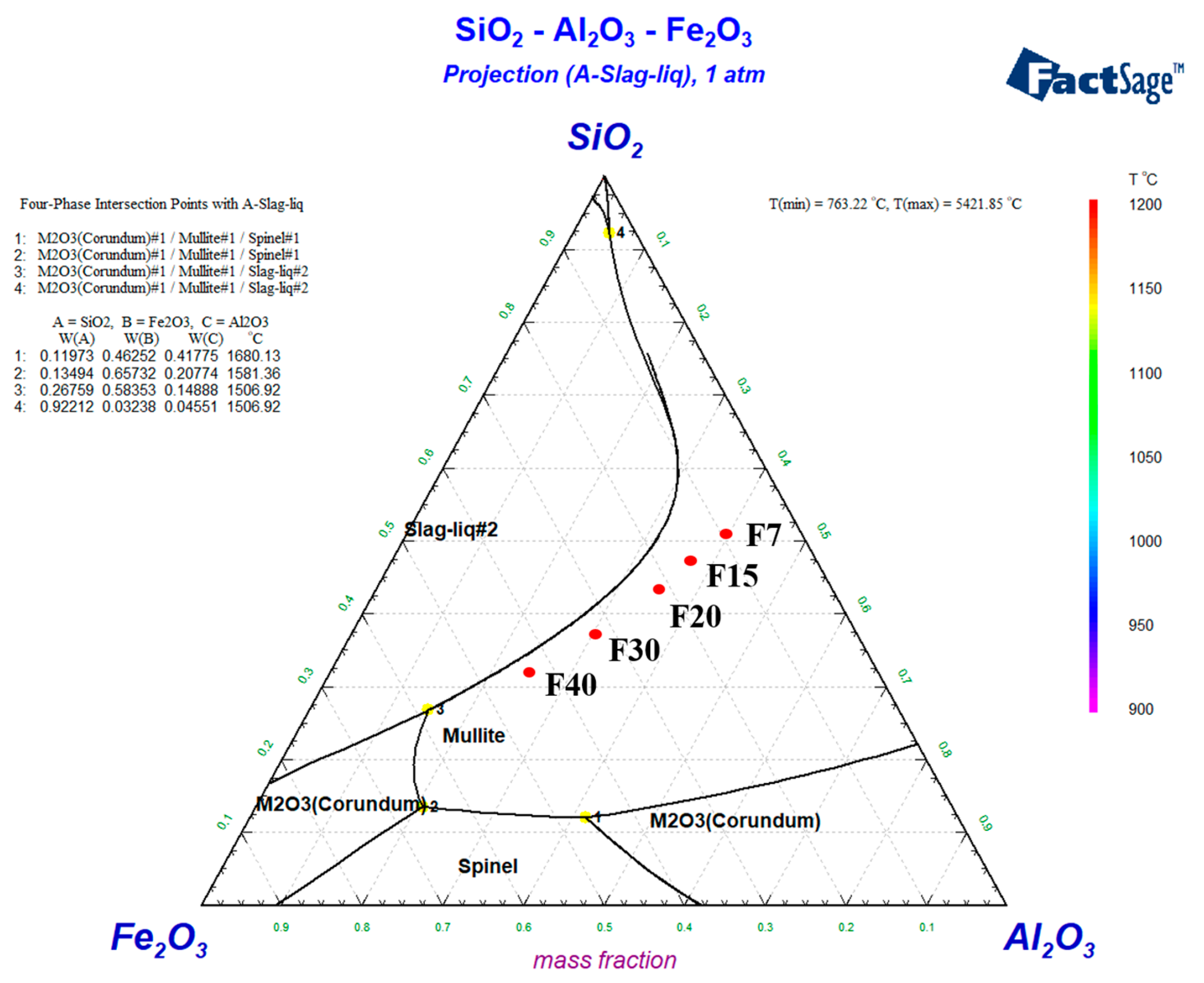
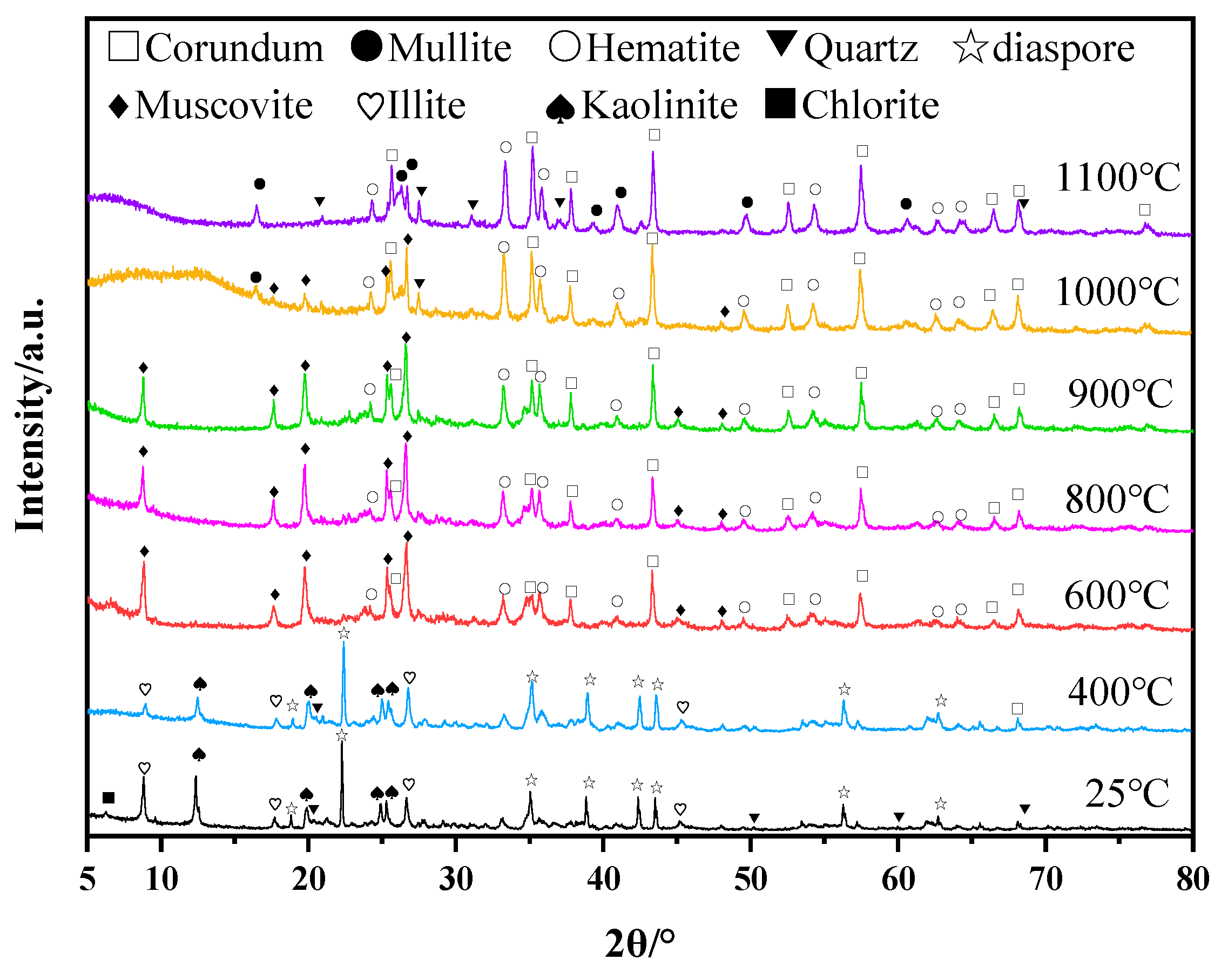
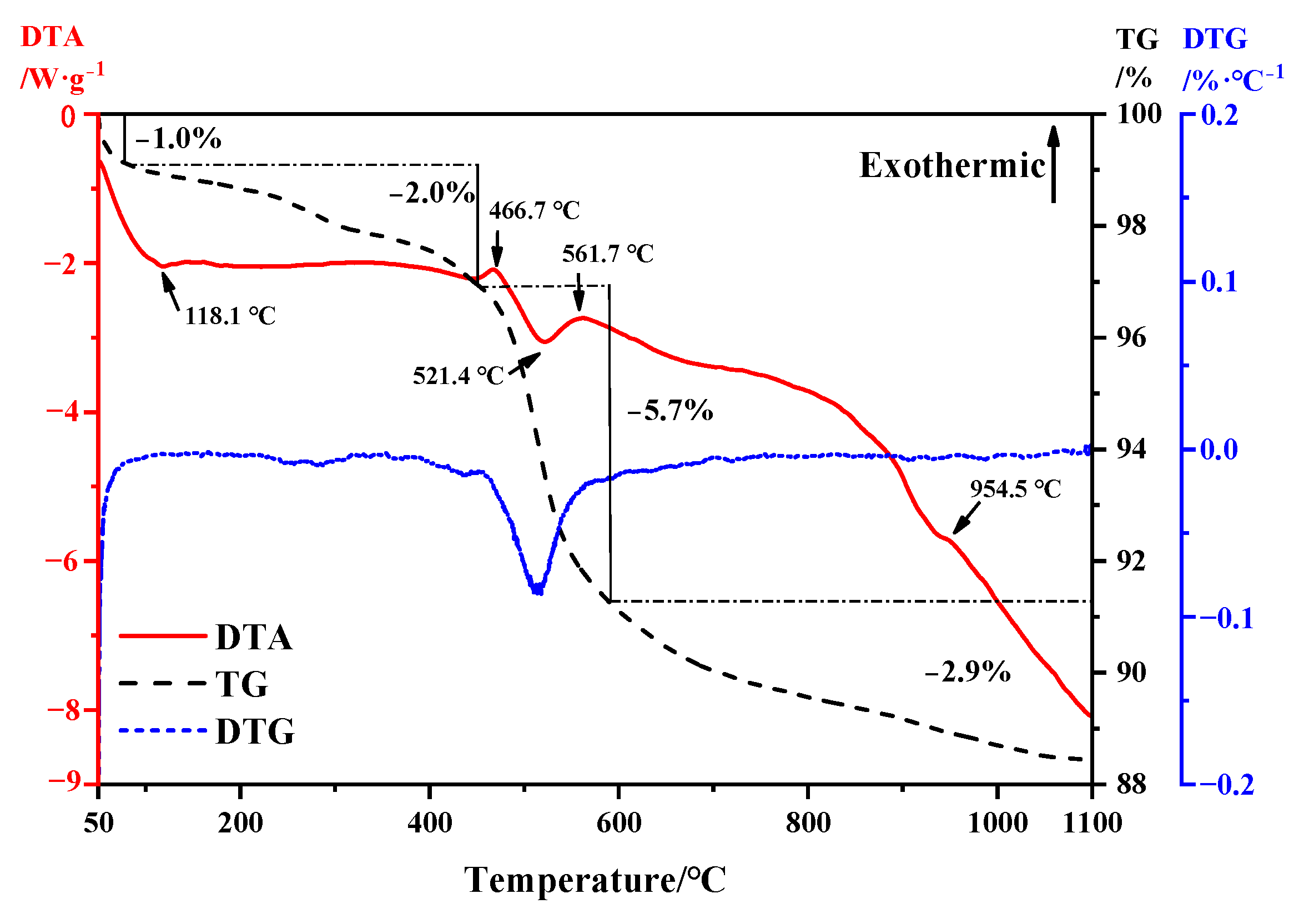
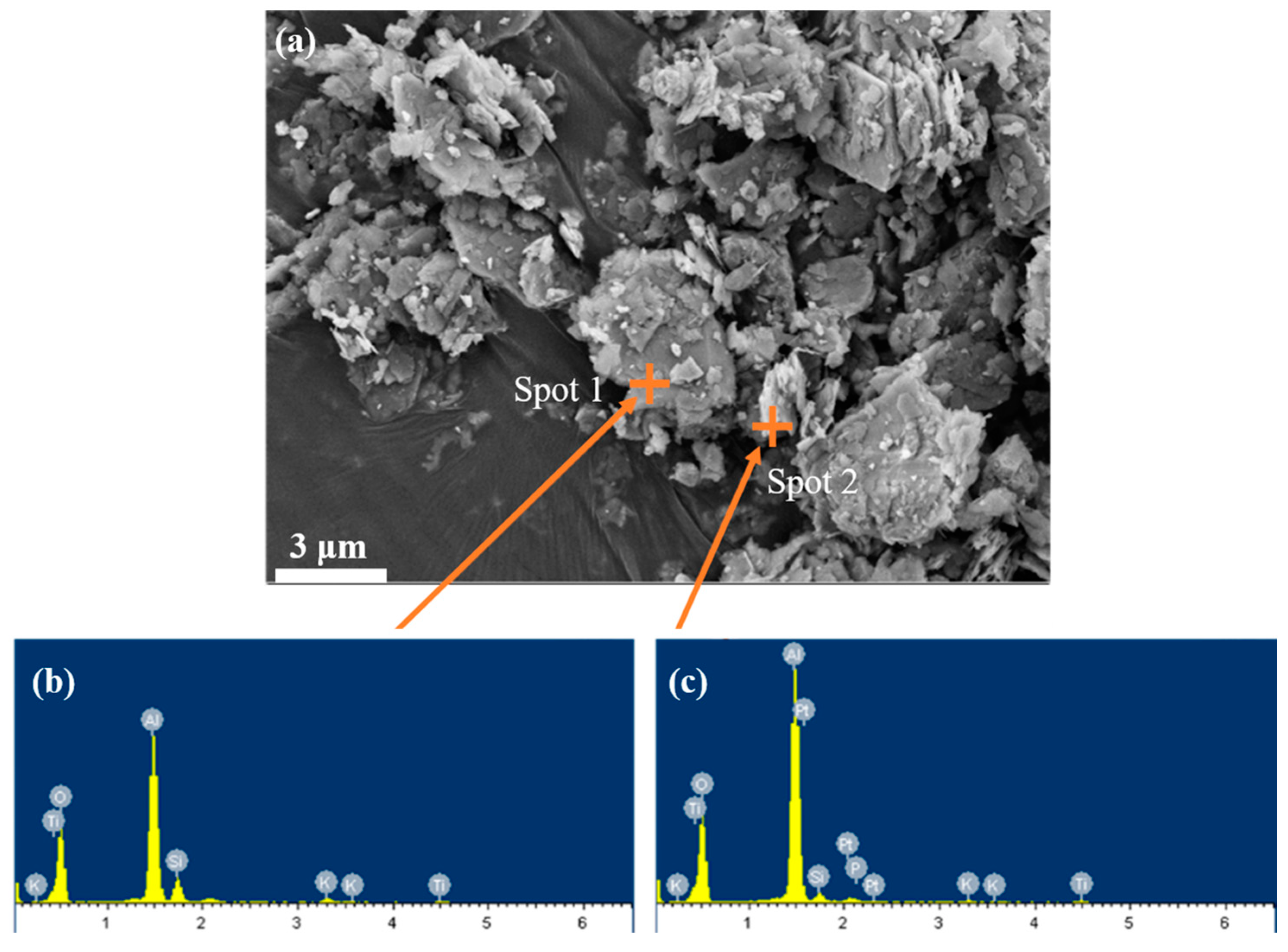
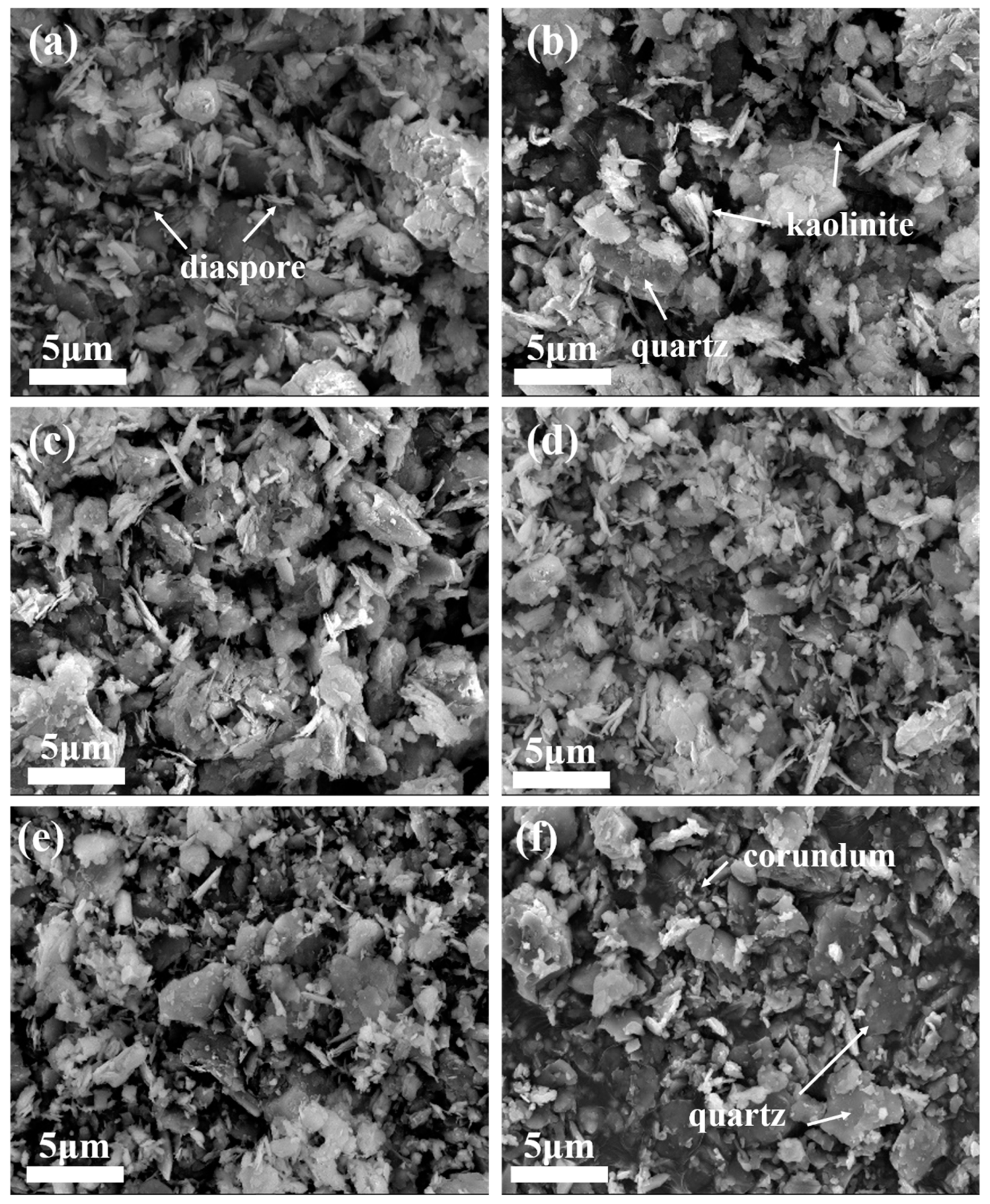
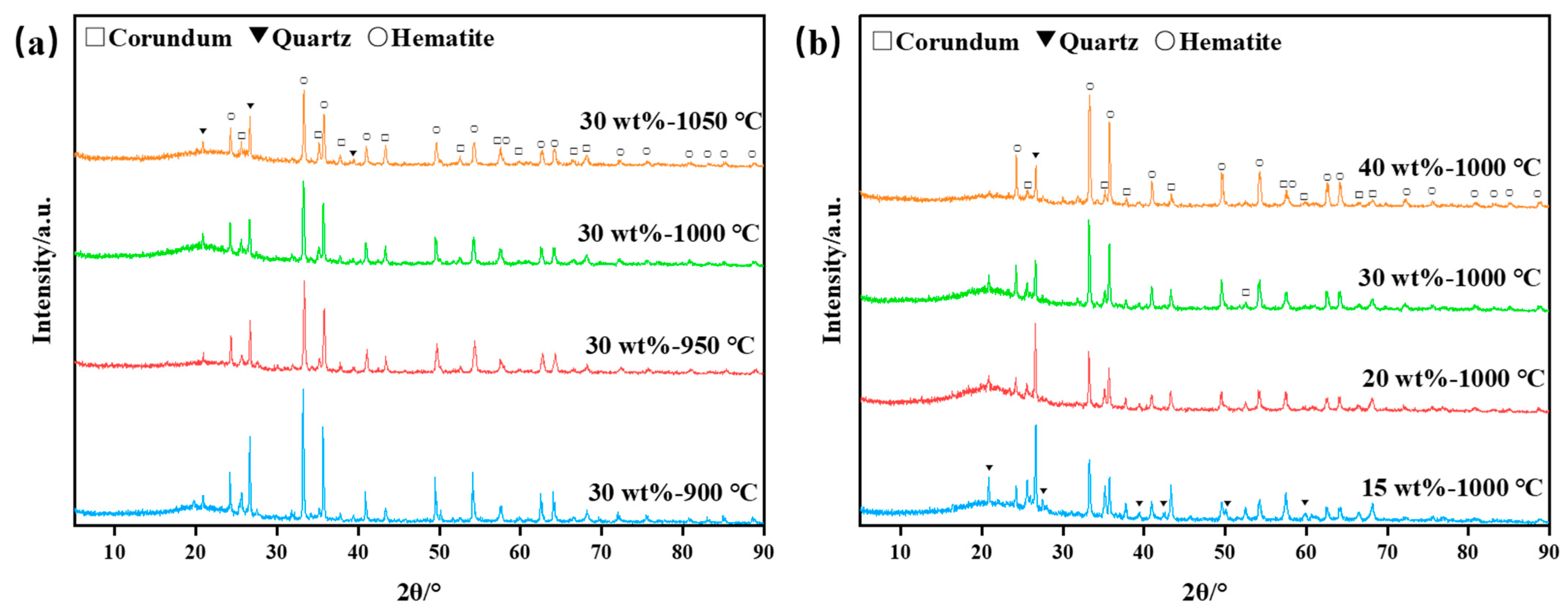

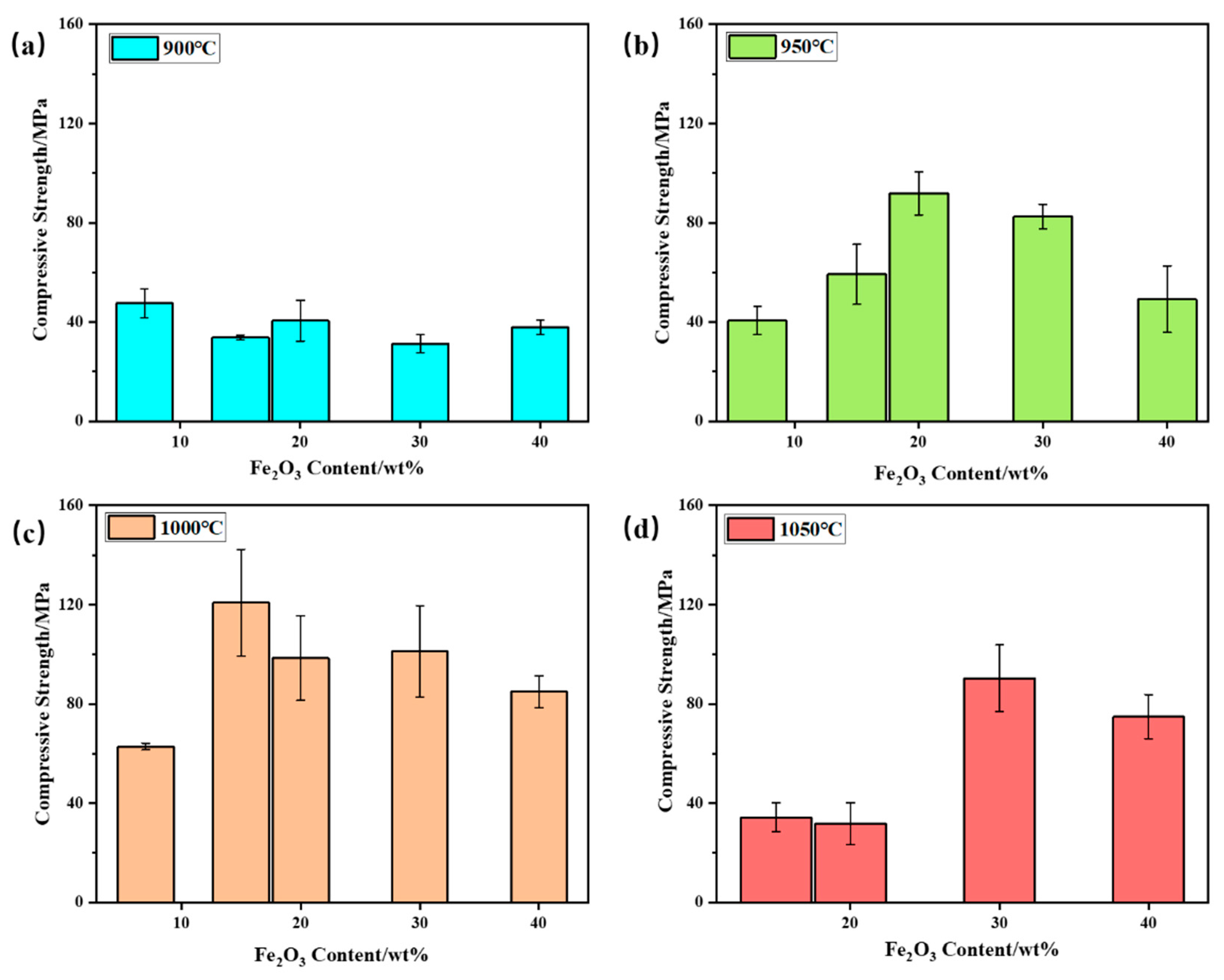
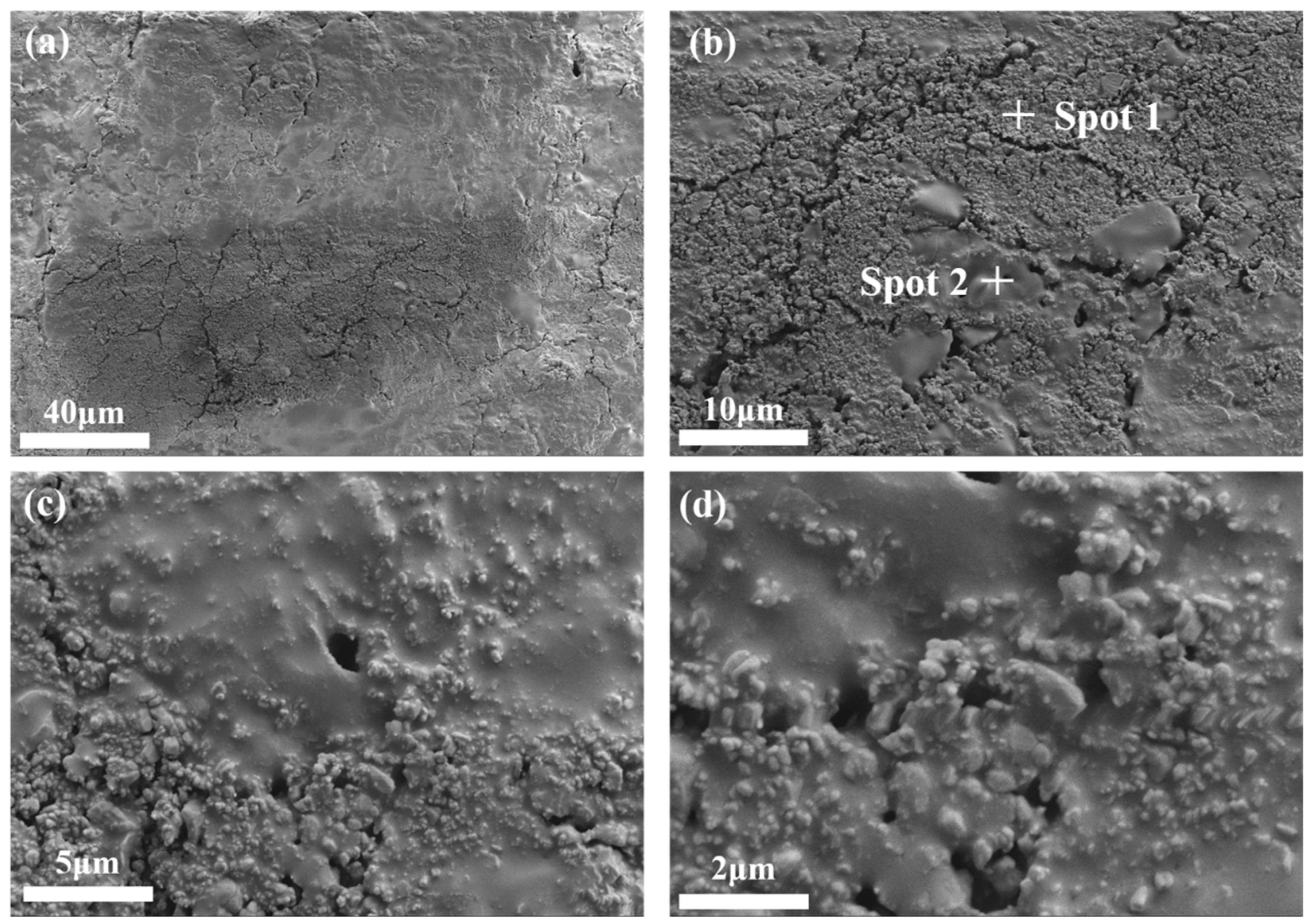
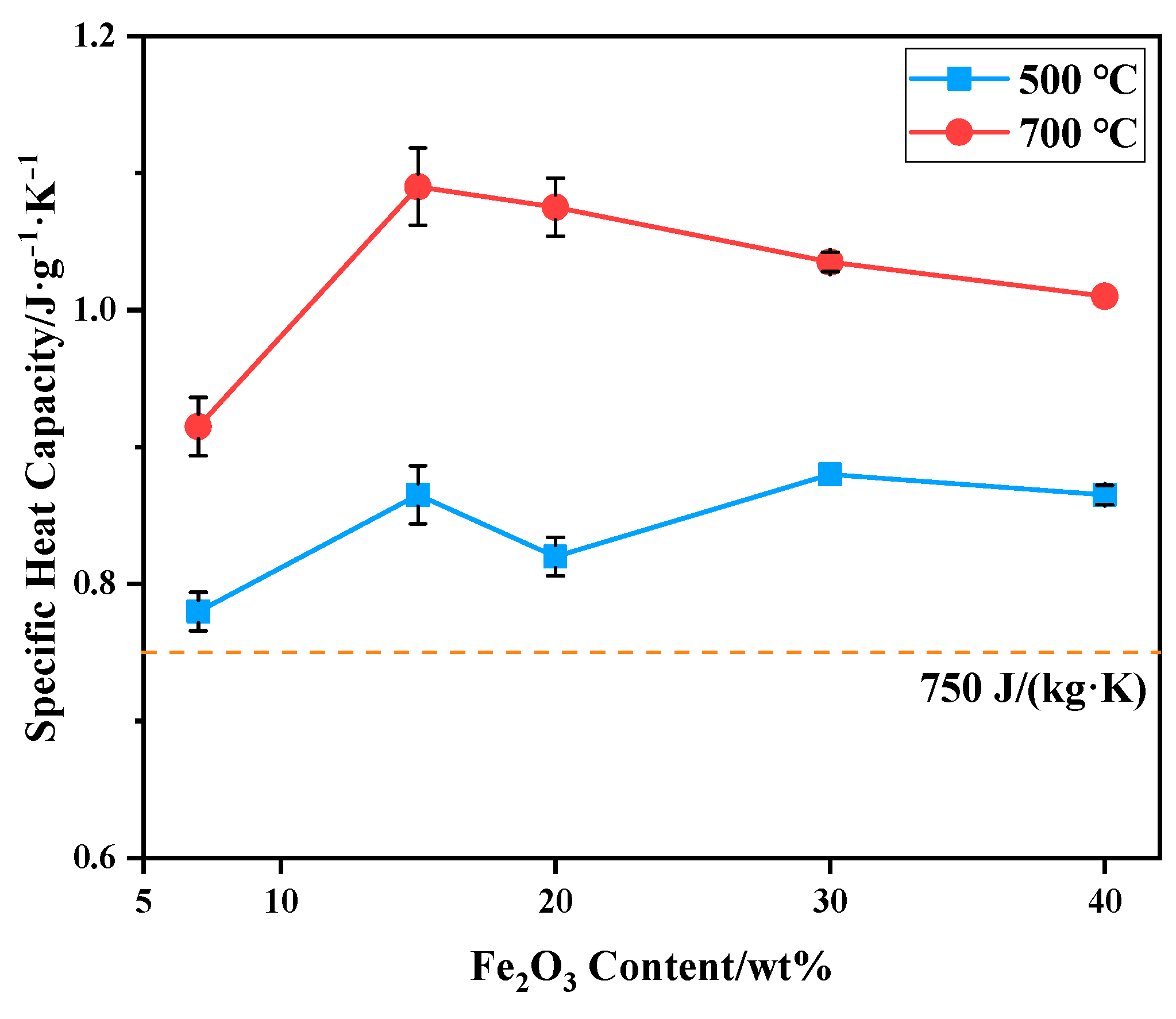
| Composition | Al2O3 | SiO2 | Fe2O3 | K2O | TiO2 | CaO | MgO | Li2O | Na2O | Others | |
|---|---|---|---|---|---|---|---|---|---|---|---|
| Weight Percentage /wt% | Bauxite tailings | 44.58 | 35.23 | 10.45 | 4.11 | 2.80 | 0.62 | 0.38 | - | 0.38 | 1.45 |
| Lepidolite | 20.36 | 65.47 | 0.09 | 3.71 | - | 3.14 | 0.19 | 2.11 | 2.39 | 2.54 | |
| Fe2O3 powder | - | - | 99.99 | - | - | - | - | - | - | - | |
| Samples | Bauxite Tailing/g | Lepidolite/g | Fe2O3 Powder/g | Al2O3 Content of Mixtures/wt% | SiO2 Content of Mixtures/wt% | Fe2O3 Content of Mixtures/wt% |
|---|---|---|---|---|---|---|
| F7 | 67 | 33 | 0 | 35.59 | 45.21 | 7.03 |
| F15 | 70 | 30 | 9.01 | 34.23 | 40.64 | 15.00 |
| F20 | 70 | 30 | 15.82 | 32.33 | 38.25 | 20.00 |
| F30 | 70 | 30 | 32.37 | 28.19 | 33.47 | 30.00 |
| F40 | 42 | 18 | 32.66 | 24.16 | 28.69 | 40.00 |
| Element | O/wt% | Al/wt% | Si/wt% |
|---|---|---|---|
| Spot 1 | 77.09 | 13.87 | 9.04 |
| Spot 2 | 87.07 | 4.98 | 7.95 |
Disclaimer/Publisher’s Note: The statements, opinions and data contained in all publications are solely those of the individual author(s) and contributor(s) and not of MDPI and/or the editor(s). MDPI and/or the editor(s) disclaim responsibility for any injury to people or property resulting from any ideas, methods, instructions or products referred to in the content. |
© 2023 by the authors. Licensee MDPI, Basel, Switzerland. This article is an open access article distributed under the terms and conditions of the Creative Commons Attribution (CC BY) license (https://creativecommons.org/licenses/by/4.0/).
Share and Cite
Wang, Q.; Fang, M.; Min, X.; Du, P.; Huang, Z.; Liu, Y.; Wu, X.; Liu, Y.; Liu, C.; Huang, F. Preparation and Performance of Ferric-Rich Bauxite-Tailing-Based Thermal Storage Ceramics. Materials 2023, 16, 6900. https://doi.org/10.3390/ma16216900
Wang Q, Fang M, Min X, Du P, Huang Z, Liu Y, Wu X, Liu Y, Liu C, Huang F. Preparation and Performance of Ferric-Rich Bauxite-Tailing-Based Thermal Storage Ceramics. Materials. 2023; 16(21):6900. https://doi.org/10.3390/ma16216900
Chicago/Turabian StyleWang, Qi, Minghao Fang, Xin Min, Pengpeng Du, Zhaohui Huang, Yangai Liu, Xiaowen Wu, Yulin Liu, Changmiao Liu, and Feihui Huang. 2023. "Preparation and Performance of Ferric-Rich Bauxite-Tailing-Based Thermal Storage Ceramics" Materials 16, no. 21: 6900. https://doi.org/10.3390/ma16216900
APA StyleWang, Q., Fang, M., Min, X., Du, P., Huang, Z., Liu, Y., Wu, X., Liu, Y., Liu, C., & Huang, F. (2023). Preparation and Performance of Ferric-Rich Bauxite-Tailing-Based Thermal Storage Ceramics. Materials, 16(21), 6900. https://doi.org/10.3390/ma16216900







